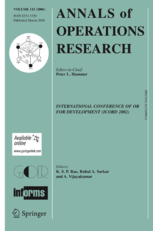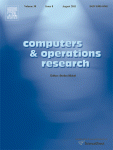research
Collaboration agreement with Fersa Energías Renovables
Thu, 01/13/2011 - 08:39 — admin Professors Narcis Nabona and F.-Javier Heredia visited the headquarters of Fersa Energías Renovables at Barcelona. Fersa Energías Renovables is the first independent company to be quoted in the Spanish stock market and one of the first in Europe dedicated exclusively to the development of clean energy. As a result of the meeting, Fersa and GNOM agreed to engage a collaboration to study the optimal integration of renewable energies in the energy production systems, and to incorporate Ms. Simona Scripante, electricity market analist of Fersa and student of the Master in Statistics and Operations Research of the UPC-BarcelonaTech, as a member of the GNOM's energy team.
Professors Narcis Nabona and F.-Javier Heredia visited the headquarters of Fersa Energías Renovables at Barcelona. Fersa Energías Renovables is the first independent company to be quoted in the Spanish stock market and one of the first in Europe dedicated exclusively to the development of clean energy. As a result of the meeting, Fersa and GNOM agreed to engage a collaboration to study the optimal integration of renewable energies in the energy production systems, and to incorporate Ms. Simona Scripante, electricity market analist of Fersa and student of the Master in Statistics and Operations Research of the UPC-BarcelonaTech, as a member of the GNOM's energy team.
New paper accepted for publication in Annals of Operations Research
Wed, 01/12/2011 - 16:47 — admin
The work A stochastic programming model for the optimal electricity market bid problem with bilateral contracts for thermal and combined cycle units of F.-Javier Heredia, Marcos J. Rider and C. Corchero has been accepted for publication in the journal Annals of Operations Research. A preliminary version of the manuscript is available at E-Prints UPC http://hdl.handle.net/2117/2282. This study, which was developed as a part of the research project DPI2008-02153, allows a price-taker generation company to decide the unit commitment of the thermal and combined cycle programming units, the economic dispatch of the bilateral contract between all the programming units and the optimal sale bid by observing the Spanish peninsular regulation.
New paper accepted for publication in Computers & Operations Research
Mon, 01/10/2011 - 17:52 — admin The work A Stochastic Programming Model for the Thermal Optimal Day-Ahead Bid Problem with Physical Futures Contracts of C. Corchero and F.-Javier Heredia, has been accepted for publication in the journal Computers & Operations Research (DOI:10.1016/j.cor.2011.01.008). A preprint version of the manuscript is available at http://hdl.handle.net/2117/2795. The goal of this work, which was developed as a part of the research project DPI2008-02153, is to optimize coordination between physical futures contracts and the day-ahead bidding which follow the MIBEL's regulation. The authors propose a stochastic quadratic mixed-integer programming model which maximizes the expected profits, taking into account futures contracts settlement.
The work A Stochastic Programming Model for the Thermal Optimal Day-Ahead Bid Problem with Physical Futures Contracts of C. Corchero and F.-Javier Heredia, has been accepted for publication in the journal Computers & Operations Research (DOI:10.1016/j.cor.2011.01.008). A preprint version of the manuscript is available at http://hdl.handle.net/2117/2795. The goal of this work, which was developed as a part of the research project DPI2008-02153, is to optimize coordination between physical futures contracts and the day-ahead bidding which follow the MIBEL's regulation. The authors propose a stochastic quadratic mixed-integer programming model which maximizes the expected profits, taking into account futures contracts settlement.The Radar Subgradient Method Applied to the Unit Commitment Problem
Fri, 12/31/2010 - 18:11 — admin| Publication Type | Conference Paper |
| Year of Publication | 2000 |
| Authors | F.-Javier Heredia; Cesar Beltrán |
| Conference Name | 9th Stockolm Optimization Days |
| Conference Date | 06/2000 |
| Conference Location | Stockholm, Sweden |
| Type of Work | Contributed presentation |
| Key Words | research, radar subgradient; guc |
| Export | Tagged XML BibTex |
Revisión y puesta a punto de programas de tiempo real de Determinación de Topología, Estimación de Estado y Reparto de Cargas Interactivo (UPC C2325).
Thu, 12/30/2010 - 14:48 — admin| Publication Type | Funded research projects |
| Year of Publication | 1995 |
| Authors | F.-Javier Heredia |
| Type of participation | Researcher |
| Duration | 07/1995-12/1996 |
| Funding organization | Electra de Viesgo S.A. |
| Partners | Dep. Estadística i Investigació Operativa, UPC. |
| Full time researchers | 3 |
| Budget | 24.812,79€ |
| Project code | UPC C2325 |
| Key Words | research; contracts; Electra de Viesgo; project; private; energy |
| Export | Tagged XML BibTex |
Desarrollo e instalación de programas de Expansión Optima de la Red Eléctrica a distintos niveles de tensión (UPC C1958).
Thu, 12/30/2010 - 14:41 — admin| Publication Type | Funded research projects |
| Year of Publication | 1993 |
| Authors | F.-Javier Heredia |
| Type of participation | Researcher |
| Duration | 10/1993-05/1995 |
| Funding organization | Electra de Viesgo S.A. |
| Partners | Dep. Estadística i Investigació Operativa, UPC |
| Full time researchers | 4 |
| Budget | 62.505,26€ |
| Project code | UPC C1958 |
| Key Words | research; contracts; Electra de Viesgo; network expansion; project; private; energy |
| Export | Tagged XML BibTex |
Desarrollo y suministro de un conjunto de programas de Coordinación Hidrotérmica a Corto Plazo de la Generación Eléctrica por flujos multiartículo en redes con restricciones laterales lineales (UPC C0919).
Thu, 12/30/2010 - 14:35 — admin| Publication Type | Funded research projects |
| Year of Publication | 1989 |
| Authors | F.-Javier Heredia |
| Type of participation | Researcher |
| Duration | 05/1989-12/1992 |
| Funding organization | FECSA-ENHER-HECSA |
| Partners | Dep. d'Estadística i Investigació Operativa, UPC |
| Full time researchers | 2 |
| Budget | 158.088,00€ |
| Project code | UPC C0919 |
| Key Words | research; contracts; multicommodity; project; private; energy |
| Export | Tagged XML BibTex |
Desarrollo y suministro de programas de Coordinación Hidrotérmica a Largo Plazo de la Generación Eléctrica empleando flujos multiartículo en redes (UPC C0606).
Thu, 12/30/2010 - 14:26 — admin| Publication Type | Funded research projects |
| Year of Publication | 1992 |
| Authors | F.-Javier Heredia |
| Type of participation | Researcher |
| Duration | 01/1989-12/1992 |
| Funding organization | Red Eléctrica de España, S.A. |
| Partners | Dept. d?Estadística i Investigació Operativa, Universitat Politècnica de Catalunya. |
| Full time researchers | 3 |
| Budget | 102.472,00€ |
| Project code | UPC C0606 |
| Key Words | research; contracts; REE; multicommodity; project; public; competitive; energy |
| Export | Tagged XML BibTex |
Optimització de fluxos no lineals amb xarxes amb constriccions a banda. Aplicació a models acoblats de coordinació hidro-tèrmica a curt termini
Wed, 12/29/2010 - 16:56 — admin| Publication Type | Thesis |
| Year of Publication | 1995 |
| Authors | F.-Javier Heredia |
| Academic Department | Dept. of Statistics and Operations Research. Prof. Narcís Nabona, advisor |
| Number of Pages | 221 |
| University | Universitat Politècnica de Catalunya |
| City | Barcelona |
| Degree | PhD Thesis |
| Key Words | research; nonlinear network flows; side contraints; hydro-thermal coordination |
| Abstract |
Com a primera part del treball de tesis doctoral, s’ha presentat la descripció, implementació i estudi computacional d’un nou algorisme de resolució del problema de fluxos no lineals amb constriccions a banda lineals. L’algorisme s’ha desenvolupat a partir d’un esquema de conjunt de constriccions actives segons la estratègia de Murtagh i Saunders del conjunt de variables superbàsics amb explotació de la estructura de xarxa amb tècniques de particionament primal. Aquest algorisme s’ha implementat, donant com a resultat el codi NOXCB 9.0, i la seva eficiència ha estat comprovada mitjançant una amplia bateria de tests computacionals. En la segona part del treball de tesis, s’ha formulat un model acoblat de coordinació hidro-tèrmica, on el parc tèrmic es descriu mitjançant un nou model de fluxos en xarxa basat en el concepte de xarxa tèrmica equivalent. S’ha descrit i programat un mètode de resolució d’aquest model acoblat basat en el paquet NOXCB 9.0, comprovant-se computacionalment el seu grau d’eficiència i precisió.
Como primera parte del trabajo de tesis doctoral, se ha presentado la descripción, implementación y estudio computacional de un nuevo algoritmo de resolución del problema de flujos no lineales con constricciones a banda lineales. El algoritmo se ha desarrollado a partir de un esquema de conjunto de constricciones activas según la estrategia de Murtagh y Saunders del conjunto de variables superbásicos con explotación de la estructura de red con técnicas de particionamiento primal. Este algoritmo se ha implementado, dando como resultado el código NOXCB 9.0, cuya eficiencia ha estado comprobada mediante una amplia batería de tests computacionales. Como segunda parte del trabajo de tesis, se ha formulado un modelo acoblado de coordinación hidro-térmica donde el parque térmico se describe mediante un nuevo modelo de flujos en redes basado en el concepto de red térmica equivalente. se ha descrito y programado un método de resolución de este modelo acoblado basado en el paquete NOXCB 9.0, comprobándose computacionalmente su grado de eficiencia y precisión.
|
| URL | Click Here |
| Export | Tagged XML BibTex |
Generalized unit commitment by the radar multiplier method
Wed, 12/29/2010 - 16:48 — admin| Publication Type | Thesis |
| Year of Publication | 2001 |
| Authors | Cesar Beltran |
| Academic Department | Dept. of Statistics and Operations Research. Prof. F.-Javier Heredia, advisor. |
| Number of Pages | 147 |
| University | Universitat Politècnica de Catalunya |
| City | Barcelona |
| Degree | PhD Thesis |
| Key Words | research; radar multiplier; generalised unit commitment; teaching |
| Abstract | This operations research thesis should be situated in the field of the power generation industry. The general objective of this work is to efficiently solve the Generalized Unit Commitment (GUC) problem by means of specialized software. The GUC problem generalizes the Unit Commitment (UC) problem by simultane-ously solving the associated Optimal Power Flow (OPF) problem. There are many approaches to solve the UC and OPF problems separately, but approaches to solve them jointly, i.e. to solve the GUC problem, are quite scarce. One of these GUC solving approaches is due to professors Batut and Renaud, whose methodology has been taken as a starting point for the methodology presented herein. This thesis report is structured as follows. Chapter 1 describes the state of the art of the UC and GUC problems. The formulation of the classical short-term power planning problems related to the GUC problem, namely the economic dispatching problem, the OPF problem, and the UC problem, are reviewed. Special attention is paid to the UC literature and to the traditional methods for solving the UC problem. In chapter 2 we extend the OPF model developed by professors Heredia and Nabona to obtain our GUC model. The variables used and the modelling of the thermal, hydraulic and transmission systems are introduced, as is the objective function. Chapter 3 deals with the Variable Duplication (VD) method, which is used to decompose the GUC problem as an alternative to the Classical Lagrangian Relaxation (CLR) method. Furthermore, in chapter 3 dual bounds provided by the VDmethod or by the CLR methods are theoretically compared. Throughout chapters 4, 5, and 6 our solution methodology, the Radar Multiplier (RM) method, is designed and tested. Three independent matters are studied: first, the auxiliary problem principle method, used by Batut and Renaud to treat the inseparable augmented Lagrangian, is compared with the block coordinate descent method from both theoretical and practical points of view. Second, the Radar Sub- gradient (RS) method, a new Lagrange multiplier updating method, is proposed and computationally compared with the classical subgradient method. And third, we study the local character of the optimizers computed by the Augmented Lagrangian Relaxation (ALR) method when solving the GUC problem. A heuristic to improve the local ALR optimizers is designed and tested. Chapter 7 is devoted to our computational implementation of the RM method, the MACH code. First, the design of MACH is reviewed brie y and then its performance is tested by solving real-life large-scale UC and GUC instances. Solutions computed using our VD formulation of the GUC problem are partially primal feasible since they do not necessarily fulfill the spinning reserve constraints. In chapter 8 we study how to modify this GUC formulation with the aim of obtaining full primal feasible solutions. A successful test based on a simple UC problem is reported. The conclusions, contributions of the thesis, and proposed further research can be found in chapter 9. |
| URL | Click Here |
| Export | Tagged XML BibTex |
